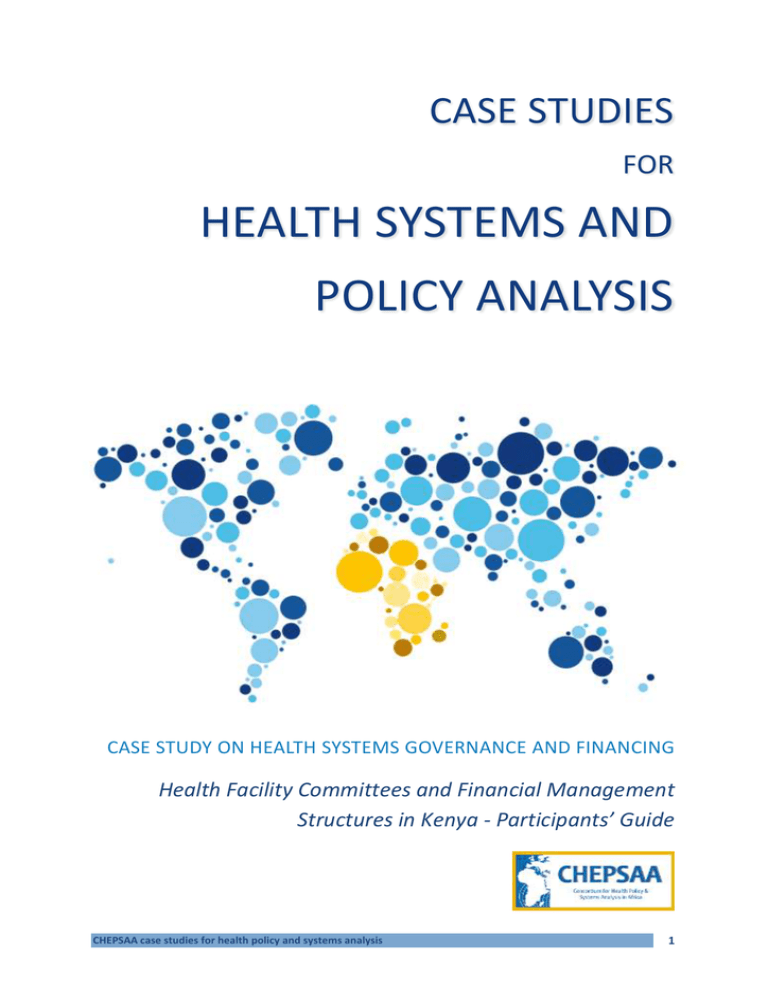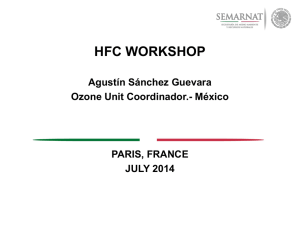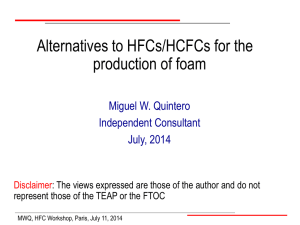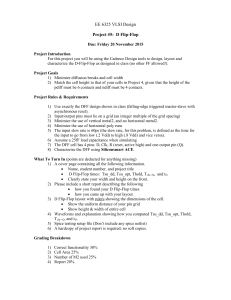Case Study - Consortium for Health Policy & Systems Analysis in
advertisement

CASE STUDIES FOR HEALTH SYSTEMS AND POLICY ANALYSIS CASE STUDY ON HEALTH SYSTEMS GOVERNANCE AND FINANCING Health Facility Committees and Financial Management Structures in Kenya - Participants’ Guide CHEPSAA case studies for health policy and systems analysis 1 The development of sustained African health policy and systems research and teaching capacity requires the consolidation and strengthening of relevant research and educational programmes as well as the development of stronger engagement between the policy and research communities. The Consortium for Health Policy and Systems Analysis in Africa (CHEPSAA) will address both of these issues over the period 2011 - 2015. CHEPSAA’s goal is to extend sustainable African capacity to produce and use high quality health policy and systems research by harnessing synergies among a Consortium of African and European universities with relevant expertise. This goal will be reached through CHEPSAA’s five work packages: 1. 2. 3. 4. 5. assessing the capacity development needs of the African members and national policy networks; supporting the development of African researchers and educators; strengthening courses of relevance to health policy and systems research and analysis; strengthening networking among the health policy and systems education, research and policy communities and strengthening the process of getting research into policy and practice; project management and knowledge management. The CHEPSAA project is led by Lucy Gilson (Professor: University of Cape Town & London School of Hygiene and Tropical Medicine). PARTNERS Health Policy & Systems Programme, the Health Economics Unit, University of Cape Town, South Africa School of Public Health, University of the Western Cape, South Africa Centre for Health Policy, University of the Witwatersrand, South Africa Institute of Development Studies, University of Dar es Salaam, Tanzania School of Public Health, University of Ghana, Legon, Ghana Tropical Institute of Community Health, Great Lakes University of Kisumu, Kenya College of Medicine, University of Nigeria Enugu, Nigeria London School of Hygiene & Tropical Medicine, United Kingdom Nuffield Centre for International Health and Development, University of Leeds, United Kingdom Karolinska Institutet, Sweden Swiss Tropical and Public Health Institute, University of Basel, Switzerland CHEPSAA WEBSITE www.hpsa-africa.org ACKNOWLEDGEMENTS An acknowledgement is given to all CHEPSAA partners who contributed to the course development process. SUGGESTED CITATION CHEPSAA. (2014). Introduction to Complex Health Systems: Case Study materials. CHEPSAA (Consortium for Health Policy & Systems Analysis in Africa) 2014, www.hpsa-africa.org This document is an output from a project funded by the European Commission (EC) FP7-Africa (Grant no. 265482). The views expressed are not necessarily those of the EC. CHEPSAA case studies for health policy and systems analysis 2 A Case Study on Health Systems Governance and Financing: Health facility committees and financial management structures in Kenya There are a number of goals or objectives we would like you to achieve through doing this case study, as listed below: Learning Objectives of the case study Identify the key agents in the case and describe their relationships within the health system, as part of the socially constructed nature of the health system. Identify the key contextual features of this case Analyse the mindsets, interests, power and agency of key agents in the situation. Analyse how the introduction of Direct Facility Funding impacted on the existing relationships among agents, and is itself affected by those reactions. Identify intended and unintended consequences of the new policy. Suggest alternative strategies that could have been used to strengthen the intervention, using systems thinking and taking into consideration both hard and soft aspects of the health system. Plan and deliver a group presentation, using effective groupwork and communication skills. Tasks After reading the case study narrative (pages 8 - 13 of this handout), do tasks A – D below in your small groups, in preparation for a 20 minute presentation about the case study which should cover the following: A. Overview of the case (5 minute presentation) – to include: 1. Key features of the case – Draw a flow diagram showing the main drivers and events of the case and how each stage had consequences, some of which were not intended. 2. Context of the case study - Complete the context analysis form on page 4 identifying the key features of this particular case and how they have contributed to the situation. B. Identify the hardware and software issues and elements which are most important in shaping this case, using guidance from Aragon’s framework below, and explain how they are linked and interact. (5 minute presentation) CHEPSAA case studies for health policy and systems analysis 3 Understanding organisa ons Hardware: Organisa onal hierarchy HR establishment Tangible so ware: Management knowledge and skills Intangible so ware: capabili es to commit and engage; adapt & self-renew; balance diversity and coherence Technology Formal management processes Finance Values & Informal rules norms Rela on- Commships unica on adapted from Aragon, 2010 C. Stakeholder analysis. Identify the key agents in the case and, situating them in the time when the DFF scheme had just been introduces, map these in diagram 1, (you can also use Form 1 on page 5 below to help your analysis) according to their levels of commitment and power to impact on successful implementation of the change. Draw lines between agents who have a close relationship with each other (e.g. through flow of money or information, lines of command or support). Consider how their position on the map changed over time, and be prepared to explain this, as well as agents’ mindsets and levels of power, and how agents are related to each other. (5 minute presentation) D. Leading and managing change. Put yourselves in the position of a Facility Management Nurse (FMN) in the case. You are well-acquainted with the challenges of implementing the intervention and are looking for support for the changes. As this facility-level leader, think about how you can improve already quite successful implementation and act against the practice of continuing to charge high user fees. Using the concepts and frameworks you have been introduced to in the course, above and in the session 7 lecture on ‘Leadership of change in health systems’, design 3 strategies to increase other agents’ understanding and buy-in – particularly HFC members and communities. These could include small wins. In developing strategies also think of the ideas raised in the Duncan Green video. (5 minute presentation) On the next two pages are templates you can use for your Context and Stakeholder Analysis. In preparing your presentation consider the following: Consider your audience, and design the presentation so that the level, language and content are appropriate for them; Make sure you have covered all the necessary/important information; Organise your points/ideas in a logically and clearly structured way; Introduce the presentation with an attention catching question or comment, and a brief preview of the content; CHEPSAA case studies for health policy and systems analysis 4 The body of the presentation should have clear main and sub-points; Keep to the allocated time (if possible ask a colleague to check the timing for you); Speak clearly and not too fast; Conclude the presentation with a brief re-statement of the main points or a summarising comment. You will use these criteria for assessing the group presentations: Assessment criteria The overview of the case is clear and succinct and gives a clear image of what the case is about. The hardware and software issues at play in the case, and their relationship, are clearly explained. The roles of actors, their mindsets, interests and power are presented and explained convincingly. The suggested strategies for leading change are well motivated. Delivery of the presentation (visual and oral) is clear, using appropriate pace and level, and content is coherently and logically structured. CHEPSAA case studies for health policy and systems analysis 5 Contextual feature Specific issues relevant to this experience (remember not all issues might be relevant to this case) Impact of these issues on actors (name these) and the case, and implications for policy implementation Micro context organisational climate & culture other policies organisational capacity interpersonal factors Macro context social & political pressures & interests historical & sociocultural context economic conditions & policy international context environmental factors CHEPSAA case studies for health policy and systems analysis 6 Form 1. Unpacking agent behavioural drivers and power AGENT Mindsets, values and interests What are the core elements of the agent’s ‘mindset’ (beliefs, values driving behaviour in general?) CHEPSAA case studies for health policy and systems analysis Forms and level of power to influence implementation Given the elements identified in column 1, is actor’s response to the change likely to be committed, compliant, indifferent, resistant, or hostile? What forms of power can the agent mobilise to support his/her actions around the new policies? What power limits does the actor face in taking action around the new policies? 7 Diagram 1: Agent map Low <<---------------------Power------------------->>.High Locate your actors on this map of support and opposition for change, taking account of their power level Very committed << compliant << indifferent >> resistant >> hostile Commitment CHEPSAA case studies for health policy and systems analysis 8 Health Facility Committees and financial management: A Kenyan case study Narrative Background This case study examines the implementation of two policies in Kenya aimed at health system strengthening. The first is Health Facility Committees (HFC’s) - an approach to broadening community participation in public health service delivery; and the second Direct Facility Funding (DFF) - a mechanism for transferring health funding to the periphery of the health system. From the 1980’s, various approaches were taken by Kenyan authorities towards reforming the health system, with the aim of leveraging improvement in utilisation and quality of care of health services. Community participation and decentralisation were important drivers of these reforms. Below is a timeline showing the development of some relevant reforms over the period covered in the case study: 1980’s Introduction of user fees to provide more revenue and therefore better health services in public health facilities; Introduction of Health Facility Committees with responsibility for disbursing most of the user fee revenue. 1998 Health Facility Committees (HFC) officially established, with prescribed roles and responsibilities, supported by funds from the Ministry of Health and the Danish International Development Agency (DANIDA) 2004 User fees reduced to widen access to public health services; however this reduced facilities’ revenue and therefore their capacity for providing services. 2004 Direct Facility Funding (DFF) scheme introduced to channel more revenue from central government to health facilities, to make up for loss of income from reduction of user fees. The scheme was piloted in Coast Province. 2005 Role of HFC’s expanded to include management of facility budgets under the DFF scheme 2007 - 2009 Government regulation regarding roles and functions, and composition of HFC’s 2010 - 2012 National roll-out of HFC’s for public health centres and dispensaries, based on perceived success of pilot CHEPSAA case studies for health policy and systems analysis 9 Health Facility Committees The Kenyan government officially established Health Facility Committees in 1998, as a contribution towards building community accountability in public health. Their roles were defined as follows: Roles of the HFC 1. To oversee the general operations and management of the health facility 2. To advise the community on matters related to the promotion of health services 3. To represent and articulate community interests on matters pertaining to health in local development forums 4. To facilitate a feedback process to the community pertaining to the operations and management of the health facility 5. To implement community decisions pertaining to their own health 6. To mobilise community resources towards the development of health services within the area Powers of the HFC 1. The committee shall have the authority to raise funds from within itself, the community or from donors and other well-wishers for the purpose of financing the operations and maintenance of the facility 2. The committee shall have authority to hire and fire subordinate staff employed by itself in the health facility 3. The committee shall oversee the development and expansion and maintenance of the physical facilities within their respective area Source: Managing a Health Facility: A Handbook for Committee Members and Facility Staff. Ministry of Health & Aga Khan Health Service, Kenya, Second Edition, 2005 [13] Committee members included the health worker in-charge of the health facility as secretary and between 8 and 18 community members. The chair and the treasurer were chosen from the community members. Most of the latter were farmers, though some were professionals such as teachers, and a few were community health workers. A few committees had Area Chiefs and Councilors as members by virtue of their official role. All committees had at least one female member as required by DFF guidelines. All HFCs had a constitution which outlined rules and codes of conduct regulating committee functioning, such as frequency of meetings. CHEPSAA case studies for health policy and systems analysis 10 HFC’s were to be supported and strengthened by management training provided by the Ministry of Health and DANIDA Health Services project. In 2005 the roles of the HFC’s were expanded to include management of budgets and funds under the DFF scheme. Direct Facility Funding (DFF) scheme Prior to 2004 primary health care services had two sources of funding: resources for infrastructure, drugs, medical supplies and staffing had been supplied by the Ministry of Health (later called the Ministry of Public Health and Sanitation), but these had often not ‘trickled down’ to facilities as intended: in some cases barely 30% of funding made it to small facilities. The only other income available to health facilities was that gathered from user fees and other income generating schemes such as the sale of mosquito nets. However, there had been pressure for the abolition or reduction of health facility user fees, as these had been seen as a barrier to health access for the poor. In 2004, Kenya removed high and variable user fees for health facilities, replacing them with flat rate fees of KES 10 (approximately US$ .15) at dispensaries, and KES 20 (approximately US$ .30) at health centres. In response to concerns that these lower fees limited the money available to health facilities for daily expenditures, the Kenyan Government and the Danish International Development Agency (DANIDA) piloted an innovative scheme of directly funding health facilities in one province in Kenya (Coast Province): Direct Facility Funding (DFF). With direct facility funding, health facilities receive money directly into their bank account. All health facilities with qualified staff were eligible for DFF, which was to be allocated according to a set of criteria based on workload and facility type. Another key provision for participation in the DFF scheme was that facilities comply with the national policy on reduced user fees. The funds are managed by the Health Facility Committee. DFF supervision was provided by the District Health Management Team (DHMT), with the team members most involved being the facility management nurse (FMN) and the district accountant. Additional oversight was provided by two provincial level accountants. The post of FMN was created to support links between facilities, the community and the district by strengthening the management of committees. This involved overseeing the selection of committee members, organizing training, and assisting committees in planning and continuously evaluating those plans. The items on which DFF could be used included: salaries, water and electricity supplies, communications, staff travel costs, office and general supplies and routine maintenance of vehicles, equipment and buildings. The wage bill could not exceed 30% of disbursed funds, and expenditure on HFC allowances and drugs was not allowed. The Government continued CHEPSAA case studies for health policy and systems analysis 11 to cover the vast majority of facility resources through in kind provision of infrastructure, trained health workers, supervision, drug kits and medical supplies. HFCs budgeted for the DFF funds within specific guidelines, implemented work plans and kept accounts. In the years following implementation the average annual income from DFF was US$4,720 and US$2,802 per health centre and dispensary, respectively. This accounted for an average of 56% of the facilities’ annual income. The remainder continued to be made up of user fees, sale of insecticide treated nets, income generating activities and donations. Despite the DFF funds, it was clear that facilities were not adhering to the user fees policy. Many continued to levy charges above the prescribed fees and failed to exempt groups of patients such as the under-fives and those with malaria. This was attributed to lack of official communication of the policy and the need for more resources at the facility level. Implementation of the DFF scheme Evaluations of the pilot phase of DFF implementation found that HFC’s were in place and functioning in most facilities, with meetings being held regularly and sitting allowance generally being paid to members. HFC’s had existed before the initiation of the DFF but had been less effective and active, and the funding they had controlled had been far less. DFF provided the means for better participation, through payment of allowances, and greater sense of ownership of the health facility. The following quote illustrates the thoughts of a health worker in this regard. ‘‘You know management without finance is not management at all. Now if it couldn’t be this DANIDA [DFF] funds these committees couldn’t be meeting often like that because they would have nothing to discuss about or to budget for.’’ (Health worker) The availability of money to pay allowances for attendance at meetings also increased participation and made the committees more viable, although members continued to see their roles as largely voluntary, and complained that allowances only partly recompensed them, and should be increased. It was important for them to feel rewarded – with both financial and non-financial incentives. The quote below is an example of members’ thinking related to this: “Previously, we depended on the cost, sharing money only and it was too little, just enough for drugs or syringes but not allowances...members would not come for meetings because there were no allowances.” (HFC member, Tana River) HFC members were happy with the opportunities they had for training and to participate in outreach programmes and health campaigns. They were sometimes allowed waivers on their health facility user fees, and given priority treatment, which added to job satisfaction in their HFC roles. Most were highly motivated and proud of to be HFC members. CHEPSAA case studies for health policy and systems analysis 12 Relationships: HFC and health workers There was generally cooperation between HFC’s and health workers, who valued the opportunity to discuss issues with HFC community members and were happy with their participation. Likewise, many HFC members expressed trust towards health workers and the in-charge: “In this committee we really trust our in-charge; the in-charge is very co-operative. But in other areas, this may not be the case...” (HFC member, Kwale) As hinted at in the quote above however, some health workers were not trusted, and were thought to be hiding financial information from the committee. In other cases, as cited earlier, HFC members were seen as ‘watchdogs’ and a ‘nuisance’ by health workers, taking their supervisory role too seriously, undermining them and encroaching on their professional space. There was some disagreement on what decisions HFC’s were able to take with regard to allocation of funds and management of the facility, and when they should be consulted on issues. This lack of clarity added to tensions between members and facility staff, with lengthy debates among committee members about the extent of their autonomy in some areas. Some HFC community members also experienced tension with regard to the oversight role given to in-charges and District Health Management Teams, who they felt constrained their ability to manage facilities and make decisions on certain issues. Some difficulties arose around the low education levels of community elected members (47% of community members had not completed secondary education and some were illiterate), which meant they could not grasp the necessary concepts or perform the required functions of the committee. One manager expressed this concern as follows: “So you can imagine teaching financial issues, all those regulations, bar lines and cash books to people who probably went to school up to say class 7, or class 6 somewhere there, it really takes long for them to grasp the concept. ” On the other hand more educated, professional members tended to intimidate others on the committee. Both of these factors contributed to tensions in the HFC’s operation. With the scale-up and introduction of the DFF scheme however, new guidelines were gazetted for HFC’s which attempted to address the difficulties by restricting the number of community members on a committee to 5, one of whom must have knowledge and experience of finance and administration. The rest of the committee was to be made up of nominated members (facility in-charge, and representatives of provincial administration, District Medical Officer for Health and area councillor). The number of women required on a CHEPSAA case studies for health policy and systems analysis 13 committee was changed from one to three, which improved the representation of vulnerable groups - still an issue for consideration. A positive role was often played by the Facility Management Nurses (FMN), who supported the committees, built links between them and communities, guided them and resolved disputes. Relationships between the facility in-charge and community members of the HFC were also noted to have improved since inception of the DFF, and in-charges tended to value the opportunity to discuss issues with community members and appreciated the local legitimacy given to the decisions of the HFC. Staff members were positive about the DFF despite the extra supervisory work it entailed for them, for which they did however receive extra pay. HFC members generally valued the support given to them by facility in-charges, nurses, district accountants and facility staff, which helped empower them to fulfil their DFF responsibilities. Relationships: HFC and the wider community Relationships between HFC’s and communities, like those between HFC’s and health workers, were also considered to be good overall, with communities happy to have representatives in the health facilities, and HFC members happy with the legitimacy of their representation. There was however found to be low awareness of HFC’s, their role, function and membership among outpatients interviewed, and significantly, very few (only 4%) had actually raised a health issue with an HFC member. Awareness was found to be higher among better educated and male interviewees. Politics in the community played a part in HFC’s at times, with political aspirants in some cases forcing HFC members to resign in order to elect their own supporters in their places. There were also reports of some members spreading rumours about others with regard to handling of funds, in order to create tensions or force resignations. Another problem was of community members making inappropriate demands on HFC members with regard to funds, as illustrated below: “...once they heard the facility was receiving some money, the community wanted us to make contributions to community projects...they do not understand that the money is used within guidelines...” (HFC Member, Tana River) A negative spin-off of conflicts which emerged between communities and HFC’s, was that they often had to be defused by the nurse in-charges, placing an additional burden on them. There was an apparent need to improve the links between HFC’s and the community they represent, and accountability to them, as well as better communication in order to build trust and transparency in the selection of committee members, roles, powers and functions of the committees, and financial accounting. CHEPSAA case studies for health policy and systems analysis 14 Outcomes of DFF process HFC’s eventually managed to disburse about 80% of funds they managed, with the pattern of spending across sites evaluated being similar – the majority being spent on travel and wages for support staff. It was felt that allocations for drugs should have been allowed, as centrally provided drug supplies were insufficient, but according to the guidelines this was not allowed. A common perception was that DFF had motivated health workers and improved their performance, with reasons being that they had more access to resources – more support staff to back their work; more funds to pay utility bills and buy non-drug supplies; and more travel allowance available to facilitate outreach work. It was expected that the additional funds from DFF would enable facilities to implement the fee reductions and exemptions gazetted earlier, but this was found not to be the case. Facilities were still over-charging clients, claiming that the DFF funds were insufficient to cover all running costs. As exempted categories such as malaria patients, pregnant women and under-5 children formed the bulk of their clientele, they could not function without user fee income. The communication from the Ministry of Health regarding the user fee reduction regulations were apparently also not clearly or formally conveyed, and therefore this was given as a reason for non-compliance. Although HFC members saw themselves as providing an important link between the community and the health facility, it was found that only 46% of exit interviewee patients from the facilities knew about the existence of the committees’ role in DFF, and even fewer were aware of their composition or selection process, or knew any of the individual members of the committees. There was also some evidence of suspicion towards the HFC by community members regarding the handling of DFF funds, leading to tensions with other members, as illustrated in the following quote: ‘‘. . . The treasurer resigned. . . he was fed up with the rumours that money was being ‘eaten’. . .’’ (Health worker) Part of the reason for poor relationships between HFC’s and communities they represented was inadequate communication of information about the role and function of the HFC in relation to DFF. For example, blackboards were supposed to be available in facilities with information about the HFC and DFF, to enhance transparency, but these were seldom fully completed or user-friendly, and were not effective in communities with high illiteracy rates. Despite such negative aspects, the perceived impact of the DFF on quality of care and increased utilisation of services was felt to be positive overall. This was mainly as a result of increased health worker motivation, facilitated by increased revenue which enabled employment of more support staff, improved drug supplies and infrastructure, reduced waiting times, and better safety and cleanliness, all leading to improved working conditions and reduced fatigue for staff, and better service delivery for clients. More revenue also CHEPSAA case studies for health policy and systems analysis 15 enabled extended opening hours at some facilities and an increase in outreach activities, and thus greater coverage and reach of services such as immunisation, ante-natal care and health education for the community. One study (Opwora et al, 2009) demonstrated that DFF can be a successful mechanism for transferring funds to the health system periphery, through active, representative and reasonably effective HFC’s. Despite DFF funds making a relatively small contribution to facilities’ revenue streams and user fees still being an important source of income, DFF had a useful, though limited impact on health service delivery in Coast Province. Readiness for the reforms to be taken forward It was felt that the results of the study carried out in Coast Province were unlikely to be generalizable to other provinces in Kenya currently, as they did not have the benefit of FMN’s in place in health facilities or the comprehensive donor support for health strengthening projects which were in place in Coast Province. The studies found some level of preparedness for HFC’s to take on broader financial roles through the DFF (now called Health Sector Services Fund – HSSF) and for the mechanisms to be rolled out nationally across Kenya; however there were many apparent challenges that might limit the potential to improve quality and utilisation of health services through the wider implementation of these reforms. These challenges need to be addressed going forward. This case study is based on the following sources: Waweru, E., Opwora, A., Toda, M., Fegan, G., Edwards, T., Goodman, C. & Molyneux, S. (2013). Are Health Facility Management Committees in Kenya ready to implement financial management tasks: findings from a nationally representative survey. BMC Health Serv Res. 2013 Oct 10;13:404. Opwora, A., Kabare, M., Molyneux, S., Goodman, C. (2010) Direct facility funding as a response to user fee reduction: implementation and perceived impact among Kenyan health centres and dispensaries. Health Policy Plan. 2010 Sep;25(5):406-18. Goodman, C., Opwora, A., Kabare, M., Molyneux, S. (2011) Health facility committees and facility management - exploring the nature and depth of their roles in Coast Province, Kenya. BMC Health Serv Res. 2011 Sep 22;11:229. CHEPSAA case studies for health policy and systems analysis 16






